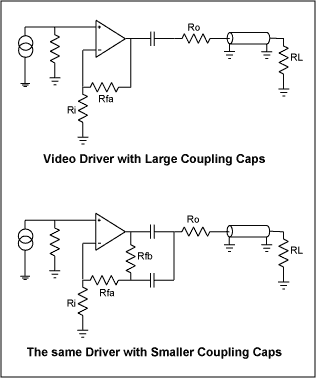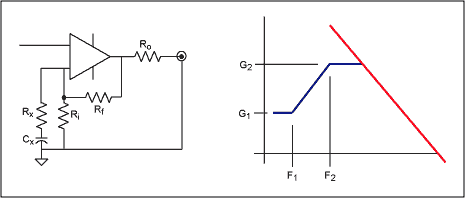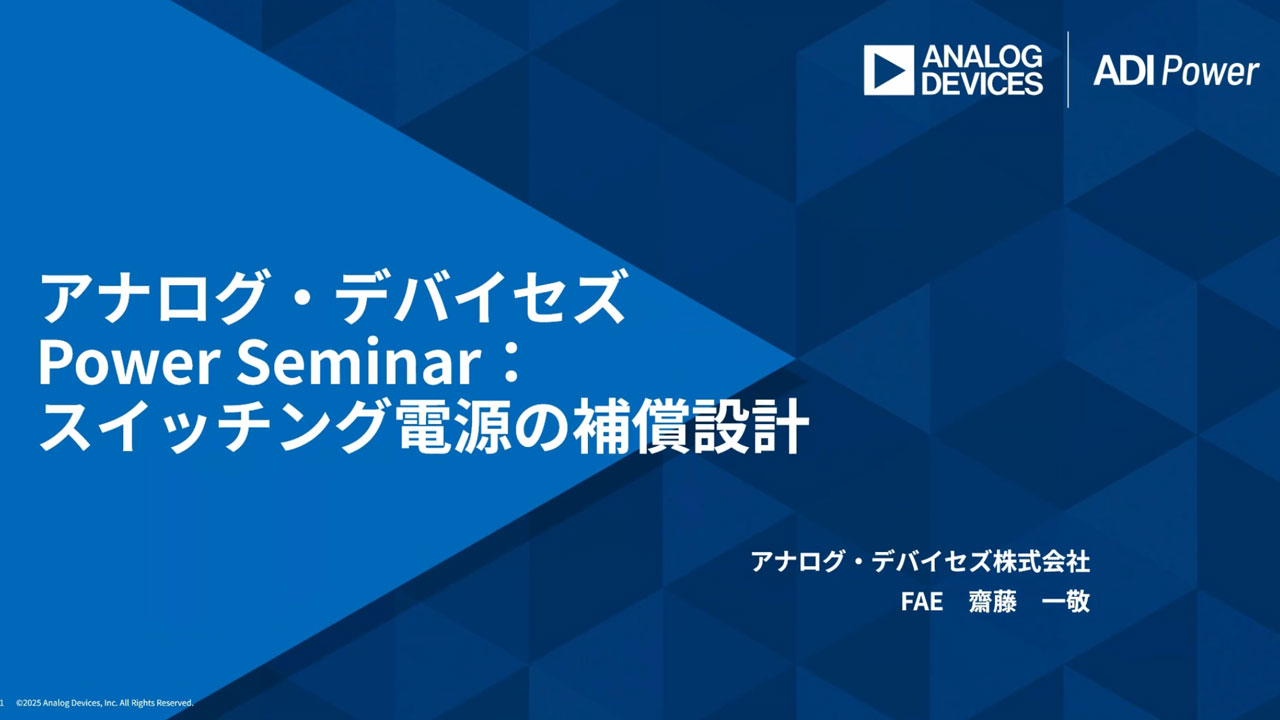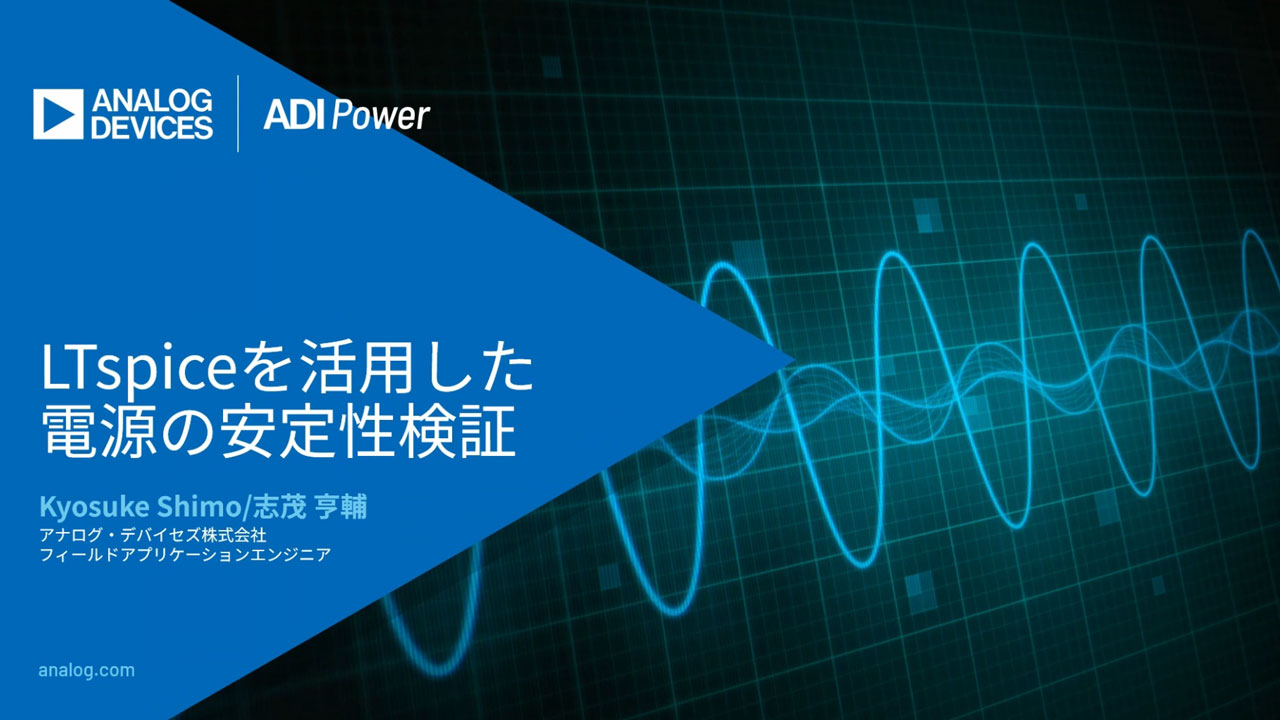要約
When does a trace or a wire become a transmission line? Bandwidth, characteristic impedance, ESD, and shoot-through considerations for selecting the proper video driver, receiver, mux-amp, or buffer.
Engineers are aware they must match impedances to avoid reflections when driving transmission lines. This is especially true in video, with its wide range of component frequencies. While most applications span a few octaves, video covers six or more.
Only dissipative elements (resistors) can be relied on for matching1 over such wide bandwidths. The use of resistors creates a loss. The driver must compensate with added gain. That's why most video drivers have a fixed gain of two2, though some are settable. This allows long lines to be equalized, restoring their frequency response to the required bandwidth for the application.
It is obvious that coaxial and differential-pair cables are transmission lines. But when does a trace or a wire become a transmission line, and is this a problem in video design?
Bandwidth
The first information needed when designing or choosing a video driver is the bandwidth. Microscopically, video is a bit-stream, and the high-frequency end depends on the rise/fall time of the waveform. To reproduce the waveform with satisfactory fidelity, the upper -3db point should be between 0.35 to 0.50 over the rise/fall time3 of the video signal, thus putting the high end of the video bandpass in the tens or hundreds of MHz. Macroscopically, video is an image, and to reproduce it we have to pass the rate at which it was sampled, or the frame rate. This sets the low end around 2.5 to 5Hz. AC coupling would require large capacitors, which is why most applications are DC coupled. It also means that the driver must sink and source current to the load, which is returned by the supply. Because of that, even DC-coupled drivers require large supply-bypass capacitors close by to avoid including the power supply trace in their design.
The size of the AC coupling caps can be reduced by "bootstrapping" the load, as shown in Figure 1. The gain is boosted at lower frequency by adding Rfb, which is shunted out at high frequency by the second coupling capacitor. This reduces the value of Cc, but you'll need two of them.

Figure 1. A method to reduce the size of the coupling capacitors by bootstrapping the load.
The next question may sound odd, but how long is the line? A transmission-line's bandwidth depends on its length. For example, at 10MHz, 100ft of RG-59A has 1.1db IL (insertion loss), 200ft has 2.2db IL, and 300ft has 3.3db4. Depending on the length, NTSC or PAL video experiences little loss, but HDTV or SXGA video would be affected. To correct for this, the line is "equalized" to restore overall response to the necessary application bandwidth. The equalizer has an inverse-frequency characteristic, compared to that of the transmission line, to create a flat response at the end of the line. A simple equalizer can be built into the driver (Figure 2), as long as the equalization (blue line) is inside the GBW of the driver (red line). This requires more gain-bandwidth in the driver, but for fixed-length lines it's less expensive than a line receiver. To allow this, some drivers have settable, rather than fixed gain.

Figure 2. A simple R-C equalizer (pre-emphasis) is used to compensate for loss between F1 and F2.
Characteristic Impedance
Transmission lines have a characteristic impedance (Zo) with which they should be driven and terminated; and, in video, the most popular is the 75Ω coaxial cable. This give the 150Ω "back terminated" unit load the driver sees due to the series 75Ω source resistor, (Ro in Figure 2) and the 75Ω line. But what about "other lines"? PCB traces and wires: are they lines?
The Long and the Short of It
To determine if a trace or wire is a transmission line, we need to know its electrical length. That's given in terms of the rise/fall time of the video (tr) by5;
L = tr/(
t/
l)
Where,  t/
t/ l is the delay per unit length (see Table 1). As the length approaches about 1/6*L it starts to look like a "line". Before that, it doesn't have a characteristic impedance, only a reactance6.
l is the delay per unit length (see Table 1). As the length approaches about 1/6*L it starts to look like a "line". Before that, it doesn't have a characteristic impedance, only a reactance6.
To get a scale of things, HDTV signals exhibit a rise-time of 20nsec, so a trace has to be about 2ft long to be a transmission line. Rise/fall times would have to approach 1-2nsec before PCB traces become transmission lines. Mainly, it's reactance that causes problems, narrow traces are series inductors, wide ones are shunt capacitors. Drivers are more tolerant of shunt capacitance than of series inductance.
Things to remember are:
- an inch of #20AWG wire has about 20nH of inductance
- an inch of 0.030 trace has 10nH
- and a sq inch of FR-4 has about 5pF of capacitance.
- inductance scales by length, capacitance by area.
| Transmission Line/Dielectric | Delay (picosec/in.) |
| Wire in Air (Vacuum) | 85 |
| Coax (RG-59A, 75Ω, 66% Propagation) | 128 |
| Coax (RG-58A, 50Ω, 66% Propagation) | 128 |
| Coax (RG-11A, 75Ω, 55% Propagation) | 154 |
| PC Board, Inside Trace (FR-4) | 140 |
| PC Board, Outside Trace (FR-4) | 180 |
Another potential problem on PCB is the "via" that connects traces between layers. At high-frequency, a Pi filter7 is formed which can "ring" on fast transitions. This is often seen in video-reconstruction-filter applications that originate from a narrow (high Zo) trace in a digital portion of a board. These signals have faster rise/fall times than video, usually set by the logic family used in the DAC. In such cases, it's best to keep the line short and terminate it as best you can. Then put a buffer or driver after the via.
Besides the length, a transmission line must be homogenous. This means it must be over a continuous return path. Even though a trace isn't a transmission line, failing to put a continuous ground under it can have subtle side effects. The first is that you can't get rid of the ringing usually followed by coax being soldered to the board. The second is cross-talk over and above what you expected, followed by more coax.
Although most PCB traces aren't transmission lines, they act as if they were. In this case, it's the return current. Don't route video lines over split planes or large gaps. It change the reactance causing ringing, and mixing ground currents causing cross-talk.
Differential Pairs
Twisted pairs, Category 3 to 6 are "Differential" transmission lines as opposed to the conventional single-ended coaxial cable. These lines have a characteristic impedance (Zo) between 100 to 150 ohms8. Typically, differential lines were used exclusively by digital signals like LVDS, but are increasing being used for analog signals; especially in existing infrastructures were coax is at a premium.
During the development of twisted pairs, two important properties were discovered; the first was the EMI radiated is lower than an equivalent coaxial cable, and the lines are less susceptible to external fields. The second was the importance of "balance" in attaining this improvement.
Just as single-ended coax cables must be properly terminated, so must differential pairs, but the signal paths must also be "balanced" or current flows outside the differential circuit9 and it starts to act like a single-ended circuit. A good way to visualize this is the differential source is composed of two perfectly symmetrical single-ended ones so that the entire signal current flows in and out of the two sources outputs, and not through the ground they may be connected to. This fact has tremendous implications for EMC. A well-balanced and terminated differential circuit may improve radiation and susceptibility as much as 30-40dB compared to coax.
The property of balance is specified differently for the driver, receiver, and line. It is further complicated by the need to convert between single-ended and differential domains.
The driver/source/line is typically specified as having a property, usually called "Common Mode Balance10", "Longitudinal Balance11" or simply "Line Imbalance12". Although balance is associated with the source, it assumes a perfectly balanced, correctly terminated, differential load. This is typically between 20 to 40 dB in digital drivers limiting their performance, however analog circuits can improve this up to a theoretical 60db at 10MHz13.
The receiver-side balance is determined by the common mode rejection ratio (CMRR). The CMRR can be quite large for even simple op amps (50-70dB), therefore the driver-side balance is the limiting factor. Assuming these are bipolar signals there has to be a quiescent point about which they swing, called the common mode voltage (CMV). Typically, this is half the supply voltage to optimize the Common Mode Input Voltage Range of the Receiver. Exceeding this range will distort the signal and possibly damage a part.
ESD and Shoot Thru
This isn't a video problem, but it does effect video drivers that are used to connect to an external load. To protect them, the output has shunt diodes to the supply and to ground to protect the driver from ESD originating outside the chassis.
New set-top boxes, video games, VCRs, DVDs and even TV sets have isolated (2-wire) chassis today, causing a potential problem called "shoot thru". Here the mains bypass capacitors called "Y Caps" charge and discharge the chassis to peak AC line potential. The chassis is also the video ground. As long as the driver is connected to equipment on that same AC line, nothing much happens, except to the well-grounded and unwary. Cable and satellite receivers have to be connected to earth-ground for operation and safety reasons. The most common connector for commercial video, the RCA jack, will likely connect the signal pin first. To avoid damaging the driver, there have to be shunt diodes at the input as well as the output.
Choosing A Driver, Receiver, or Buffer
Tables 2 and 3 show large-signal bandwidth (2Vp-p), slew rate, differential gain and phase, and supply voltage for Maxim's most popular video drivers, buffers, and receivers with single-ended and differential outputs.
A special subset of the video driver is the video-distribution amplifier (see Table 4). Built to drive multiple loads, they offer higher isolation, selectable outputs, fixed or settable gain and are often used in professional equipment.
Another subset of the video driver is the video mux-amp (see Table 5). Mux-amps combine a video multiplexer and a video line driver for routing video signals.
Table 2. Single-Ended Video Line Drivers and Buffers
| P/N | No. of Amps | Operating Voltage (V) | -3dB LSBW (MHz) | Slew Rate (V/µs) | DP/DG (°/%) | Notes |
| MAX4450/1 | 1 / 2 | +5, ±5 | 175 | 485 | 0.08/0.02 | SC70/SOT23 Packages |
| MAX4350/1 | 1 / 2 | ±5 | 175 | 485 | 0.08/0.02 | SC70/SOT23 Packages |
| MAX4380-4 | 1 / 2 / 3 / 4 | +5, ±5 | 175 | 485 | 0.08/0.02 | SC70/SOT23 Packages, Disable Available |
| MAX4389-96 | 1 / 2 / 3 / 4 | +5, ±5 | 127 | 200 | 0.015/0.015 | SC70/SOT23 Packages, Disable Available |
| MAX4012/16/18/20 | 1 / 2 / 3 / 4 | 140 | 600 | 0.02/0.02 | Disable Available | |
| MAX4212/13/16/18/20 | 1 / 2 / 3 / 4 | +3.15 to +11 | 180 | 600 | 0.02/0.02 | Disable Available |
| MAX4214/15/17/19/22 | 1 / 2 / 3 / 4 | +3.15 to +11 | 140 | 600 | 0.02/0.04 | Gain of 2 Buffer, Disable Available |
| MAX4214/15/17/19/22 | 1 / 2 / 3 / 4 | +3.15 to +11 | 220 | 600 | 0.02/0.04 | Gain of 2 Buffer, Disable Available |
| MAX477 | 1 | ±5 | 200 | 1100 | 0.01/0.01 | 130MHz 0.1dB Gain Flatness |
Table 3. Differential Video Line Drivers and Receivers
| P/N | No. of Driver/Receiver | Operating Voltage (V) | -3dB LSBW (MHz) | Slew Rate (V/µs) | DP/DG(°/%) | Notes |
| MAX435 | Driver | ±5 | 275 | 800 | Not Specified | 300µV Input Offset Voltage |
| MAX4142 | Driver | ±5 | 180 | 1400 | 0.01/0.01 | Fixed Gain of 2V/V |
| MAX4147 | Driver | ±5 | 250 | 2000 | 0.03/0.008 | Fixed Gain of 2V/V |
| MAX4447/8/9 | Driver | ±5 | 405 | 6500 | 0.01/0.02 | Single-Ended Input |
| MAX436 | Receiver | ±5 | 275 | 800 | Not Specified | 300µV Input Offset Voltage |
| MAX4144/5/6 | Receiver | ±5 | 110 | 1000 | 0.03/0.03 | Shutdown Mode |
| MAX4444/5 | Receiver | ±5 | 500 | 5000 | 0.05/0.07 | Shutdown Mode |
Table 4. Distribution Amplifiers
| P/N | No. of Outputs | Operating Voltage (V) | -3dB LSBW (MHz) | Slew Rate (V/µs) | DP/DG (°/%) | Notes |
| MAX4135/6 | 6 | ±5 | 185 | 1000 | 0.1/0.1 | 0.1dB Gain Flatness to 40MHz |
| MAX4137/8 | 4 | ±5 | 185 | 1000 | 0.1/0.1 | 0.1dB Gain Flatness to 40MHz |
Table 5. Video Mux-Amps
| P/N | Inputs: Outputs | Operating Voltage (V) | -3dB LSBW (MHz) | Slew Rate (V/µs) | DP/DG (°/%) | Notes |
| MAX4310 | 2:1 | +5, ±5 | 110 | 460 | 0.06/0.08 | Unity Gain Stable |
| MAX4311 | 4:1 | +5, ±5 | 100 | 430 | 0.06/0.08 | Unity Gain Stable |
| MAX4312 | 8:1 | +5, ±5 | 80 | 345 | 0.06/0.08 | Unity Gain Stable |
| MAX4313 | 2:1 | +5, ±5 | 40 | 540 | 0.09/0.03 | Fixed Gain of 2 |
| MAX4314 | 4:1 | +5, ±5 | 90 | 430 | 0.09/0.03 | Fixed Gain of 2 |
| MAX4315 | 8:1 | +5, ±5 | 70 | 310 | 0.09/0.03 | Fixed Gain of 2 |
Notes
- Wideband Circuit Design, Carlin, ISBN0-8493-7897-4
- Although the terms are often interchanged, video buffers as opposed to video line drivers, usually have a gain of +1V/V.
- High Speed Digital Design, Johnson and Graham, ISBN 0-13-395724-1
- Transmission Line Design Handbook , Waddell, ISBN 0-89006-436-9
- High Speed Digital Design, Johnson and Graham, ISBN 0-13-395724-1
- Wideband Circuit Design , Carlin, ISBN0-8493-7897-4
- Transmission Line Design Handbook , Waddell, ISBN 0-89006-436-9
この記事に関して
製品
1入力/4出力ビデオ分配アンプ
1入力/6出力ビデオ分配アンプ
高速、低歪み、差動ラインレシーバ
高速、低電力、単一電源マルチチャネル、ビデオマルチプレクサ/アンプ
高速、低電力、単一電源マルチチャネル、ビデオマルチプレクサ/アンプ
高速、低電力、単一電源マルチチャネル、ビデオマルチプレクサ/アンプ
高速、低電力、単一電源マルチチャネル、ビデオマルチプレクサ/アンプ
高速、低電力、単一電源マルチチャネル、ビデオマルチプレクサ/アンプ
高速、低電力、単一電源マルチチャネル、ビデオマルチプレクサ/アンプ
超小型、低コスト、85MHzオペアンプ、レイルトゥレイル出力およびディセーブル付
イネーブル付き、超小型、300MHz、単一電源、レイルトゥレイルオペアンプ
超高速、低歪み、差動シングルエンドラインレシーバ、イネーブル付
6500V/µs、広帯域、高出力電流、シングルエンドから差動ラインドライバ、イネーブル付
高速、単一電源、利得2、閉ループ、レイルトゥレイルバッファ、イネーブル付
超小型、低コスト、210MHz、単一電源オペアンプ、レイルトゥレイル出力付
超小型、低コスト、210MHz、単一電源オペアンプ、レイルトゥレイル出力およびディセーブル付
超小型、低コスト、210MHz、デュアル電源オペアンプ、レイルトゥレイル出力付
低コスト、高速、レイルトゥレイル出力付き、単一電源オペアンプ
250MHz、低電力、高出力電流、差動ラインドライバ
250MHz、広帯域、トランスコンダクタンス・アンプ、差動出力付
300MHz、高速オペアンプ
250MHz、広帯域、トランスコンダクタンス・アンプ、差動出力付
300MHz、低電力、高出力電流、差動ラインドライバ




















